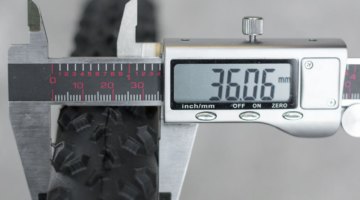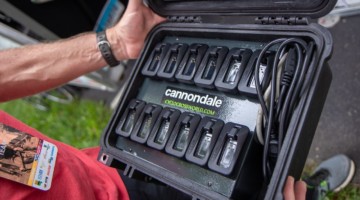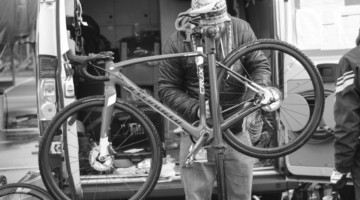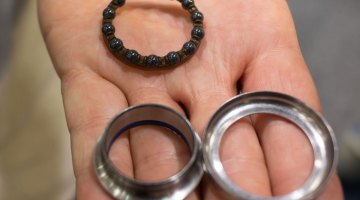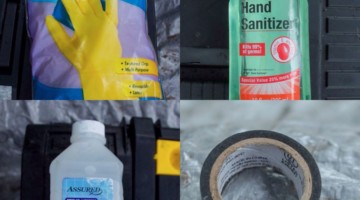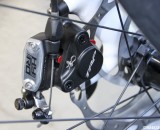
Will switching to the TRP Brakes HY-RD cable-actuated hydraulic disc brake make life easier? © Cyclocross Magazine
One of our readers asked, “If I switch to disc brakes, what’s going to be different in terms of maintenance?”
One of our trusty mechanical experts, Drew Hager, weighs in:
I think for many cyclocrossers coming from a roadie background the idea of disc brakes is daunting and full of hassle, while those coming from a mountain biking background or having at least ridden a modern mountain bike will realize that there is little to no added maintenance.
In many ways, maintenance is simplified, cleaning is easier and brake pads are removed, installed and adjusted easier. Rim integrity is increased due to brake track wear not being a problem. An out-of-true wheel causes less issues, and won’t cause energy-sapping brake rub. If you are using a cable pull mechanical disc brake system, the adjustments are made similarly, just with a different mechanism.
The main two things I would point out that will need to be routine are pad adjustments. They will need to be made as pads wear and you will need to monitor pad wear.We all heard the stories at Nationals and Worlds this past year, how pads can wear in the matter of a single muddy race … This is true but most mechanics will use pads of a different compound in wet than in dry conditions (many even mix and match a pair of pads accordingly) and you will always need to have a spare pair and probably a spare set of rotors too.
If you will be upgrading to a hydraulic disc set-up, than your worries will be considerably less. Unlike replacing contaminated cables after the muddy events you will, barring any catastrophe, rarely need to bleed the system if initially done the correct way, and your pads will self-adjust with wear.
Another complication worth considering if you’re looking to move to disc brakes is that buying (or borrowing, or getting a spare wheel at the races) wheels isn’t as straight forward as it is with cantilever brake-equipped bikes. With rim brakes, you can pretty much grab any 700c wheelset and know that besides changing out brake pads (if you have a carbon rim), they’ll work with your bike, and you’re ready to go. With disc brakes, here are variables the Cyclocross Magazine’s team thinks you should be aware of:
- Hub spacing and type: Not all 700c/29er disc brake wheels are cyclocross bike compatible. With many mountain bikes going thru axle front and rear, and moving to 142mm rear spacing, you need to make sure the wheels you purchase will fit your bike, which typically is designed for a 100mm wide quick release front hub and 135mm rear quick release hub (although some cyclocross disc brake bikes use 130mm rear spacing). Some wheels, including Ritchey’s Vantage II 29er wheels and Notubes.com’s Iron Cross wheels have caps and adapters that can convert the wheels to thru axle or quick release.
- Rotor style and size: You won’t be able to just grab any rotor or your buddy’s spare wheel and expect it to work perfectly on your bike. Rotors come in IS six bolt and Shimano Centerlock attachment styles, and come in a handful of sizes, the most popular being 140mm and 160mm in cyclocross, but mountain bikes also use 185mm and 203mm rotors. The Cannondale p/b CyclocrossWorld team runs 140mm front and rear rotors, while many bikes are featuring either a 160mm front and rear rotor or a 160mm front and 140mm rear rotor combination. This dramatically reduces your chances of getting a compatible wheel from neutral support at the races until disc brakes become popular and the industry agrees on one size.
- Swapping wheels: While one would hope all hubs and rotors would be built to perfect tolerances, positioning the rotor in the exact same spot on any wheel, manufacturing is never that precise, and because there’s not a ton of room between the brake pads and rotors (especially on single piston mechanical disc brakes, which is pretty much every brake on the market except for the TRP Spyre dual piston mechanical disc brake), swapping wheels means you could end up with rotor rub and need to adjust the pad or caliper position for a free-running wheel.
- Rotor and brake pad burn in: Jump on a bike with a never-been-ridden set of brake pads and rotors, hit a steep hill, and you might be scared to death with the lack of braking power. Getting your pads and rotors to work properly requires a bit of “burn in,” often involving a dozen or so short stops, and getting some pad material on the rotors to increase friction. It doesn’t take a ton of time, but means you shouldn’t swap a rotor and expect to ride without a bit of prep.
Despite the above variables, at this point in the game, it seems to me that disc brakes are an impending inevitability and as far as I can see so far, the trade-off of any maintenance seems like a worthy bargain for better, less stressful braking.
What do you think? Have you made the switch already, or are planning to for this season? Let us know in the comments!























